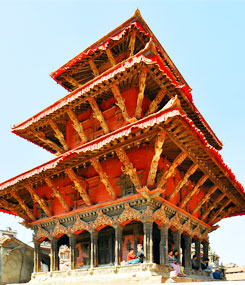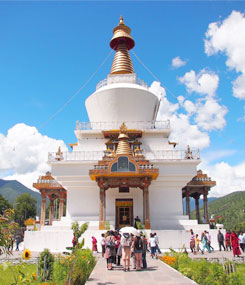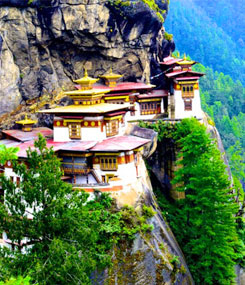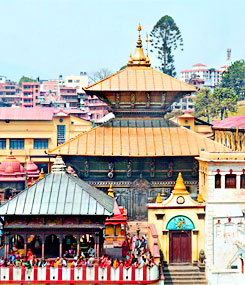Nepal Tour with Bhutan
Duration : 07 Nights / 08 Days
Destination : Kathmandu – Paro – Thimpu – Punakha – Kathmandu
Meet, assist and greet at the airport. Transfer to the hotel. Rest of the day free at the leisure
Overnight at the hotel. [-/-/-]
Kathmandu City : Here you will visit the temple of the Living Goddess, who acknowledges the greetings of the devotees from the balcony of her temple residence. Kasthamandap – the source of the name Kathmandu and supposed to be made from the timber of a single tree and Durbar Square are with its array of temples overlooked by the Hanuman Dhoka Palace, the ancient residence of the Nepalese Royalty.
The Kumari Goddess : Chosen at the age of four or five, the Kumari Devi is the most important of the several living goddesses in Nepal, selected using very strict criteria, she moves into the temple with her family, leaving only to attain a few festivals each year. She sits on the balcony regularly, acknowledging the greetings of devotees. Her reign however lasts only until puberty, when she becomes a normal mortal again.
Swayambhunath : Perched on a hilltop on the southwestern part of Kathmandu, Swayambhunath is one of the most important religious and cultural sites in Nepal and is associated with the birth of the Kathmandu Valley civilization. Approximately 2000 years old, Swayambhunath stupa, is a dome 20 meters in diameter and 32 meters high and is made of brick and earth mounted by a conical spire capped by a pinnacle of copper gilt. Many other smaller temples and places of religious importance for both Hindus and Buddhists, a perfect example of the symbiotic co-existence of different religious beliefs only found in Nepal surround it. The hill is heavily wooded on all sides with indigenous plant species, and troops of monkeys, giving it the nickname of "Monkey Temple". The height of Swayambhunath also makes it a good vantage point and on clear sunny days one can see the Himalayas all the way to the east.

Patan Durbar square, Kathmandu
Patan or Yala : Patan as it is known today is located on the southern banks of the Bagmati River and is one of the three main cities in Kathmandu Valley. The city is believed to be the first settlement in the Valley and was established by the Kirat dynasty who ruled for more than 1200 years from the 3rd century BC. Patan is famous for its amazing collection of fantastically carved temples, palace courtyards, water spouts, public baths and houses with their equally elaborate wood, stone and metal carvings under the patronages of the Kirat, Lichivi and Malla kings.Patan has more than a 1000 temples and monuments dedicated to the uniquely Nepali mix of Buddhist and Hindu gods, chief among which are the mounds erected by the great Indian Emperor Asoka in the four corners of the city when he visited Nepal in 250 BC. Patan Durbar square is one of the seven Monument Zones that make up the Kathmandu Valley UNESCO World Heritage Site.
Overnight at the hotel. [B/-/-]
Driving distance : 54 km
Estimated travel time: 1 hour and 30 minutes.
Fly into Paro by Druk Air, Royal Bhutan Airline. The great snow-capped peaks of the inner Himalayas rise up to the heavens can be seen during clear weather.
You will be received at the Paro airport. After completion of airport formalities, you will drive through the lovely Paro valley to Thimphu , the capital city of Bhutan. The road runs down through the Paro valley, to Chuzom (Confluence) at the entrance to the valley, where the Paro and Thimphu rivers meet. Three chortens (Stupa) on the riverbank at this place, each in a different style, mark the confluence of the two rivers. The road passes along a narrow valley with high, rocky cliffs on the left, and then the valley opens out into farmland on the approach to Thimphu.

National Memorial Chorten, Thimphu
On arrival at Thimphu, check into the hotel. After refreshments, sightseeing in Thimphu valley which includes visits to some of the following depending on your interest and time availability: The National Memorial Chorten, continuously circulated by the faithful, murmuring mantras and spinning their prayer wheels. Construction of this landmark was the idea of Bhutan's third king, His Majesty Jigme Dorji Wangchuck ("the father of modern Bhutan") who had wished to erect a monument to world peace and prosperity. Completed in 1974 after his untimely death, it serves both as a memorial to the Late King and as a monument to peace. Later visit Tashichhodzong, "the fortress of the glorious religion". This is the center of government and religion, site of the monarch's throne room and seat of the Je Khenpo or Chief Abbot. Built in the 15 century by the political and religious unifier of Bhutan, Shabdrung Ngawang Namgyal, it was reconstructed in the 1960s in traditional Bhutanese manner, without nails or architectural plans.
Overnight at Thimphu [-/L/D]
Driving distance to Punakha : 77Km
Estimated travel time: 2 hours and 30 minutes.
After breakfast visit National Library, housing an extensive collection of priceless Buddhist manuscripts.The National Institute of Traditional Medicine, where Bhutan's famed traditional herbal medicines are compounded and dispensed.The school of traditional arts and crafts(commonly known as ZorigChusom), where students undergo a 6-year training course in Bhutan's 13 traditional arts and crafts.The National Textile Museum, which is a good place to see the art of Bhutanese traditional weaving kept alive and preserved through exhibition and has a goodcollection of old textiles which are rich in colors and designs. Women weaving intricate designs can also be seen here.The Folk Heritage Museum that gives an insight into Bhutanese rural life.
Evening drive to Punakha across Dochu la pass (3088m) where you will visit Druk Wangyel Chortens( 108 stupas) and Druk Wangyel Temple.
Overnight at Punakha [B/L/D]
Driving distance to Paro : 135 km
Estimated travel time : 4 hours
After breakfast visit visit the PunakhaDzong, Placed strategically at the junction of the Pho Chu and Mo Chu rivers, the dzong was built in the 17th century by ZhabdrungNgawangNamgyal to serve as the religious and administrative seat of the region. It was here that the dual system of government was introduced and in 1907, enthroned the first King GongsarUgyenWangchuck. Damaged over the centuries by four catastrophic fires and an earthquake, the dzong has been fully restored in the recent years by the 4th King JigmeSingyeWangchuck. At the Dzong enrich your trip with the opportunity to see the highest standards in woodwork. Do not miss the massive Kuenray, the Coronation Hall of all Bhutanese kings, the Dzongchung at the entrance to the dzong and the cantilever bridge over the Mochu that has been recently renovated.
Later en-route to Paro valley, stop at Lobesa to visit the Devine Madman's Monastery-ChhimiLhakhang, famously known for its fertility shrine, where couples unable to concieve come here for blessing. Have your luch at theChhimiLhakhang cafeteria which is located near the monastery before continuing the journey towards Paro.
Overnight at Paro [B/L/D]

Paro Takatsang, Paro
After breakfast, travel to Paro which will take about 1 hour and on arrival at Paro hike to TaktsangGoempa (Tiger's Nest Monastery). The hike upto the viewpoint will take about 1 1/2 hours and from there you will enjoy a spectacular view of the monastery clinging to the side of the cliff.You will stop here for refreshments and then hike further upto the monastery which should take another 1 1/2 hours. It was first built in 1692, around the TaktsangSengeSamdup, a cave where Guru Padmasambhava is said to have meditated for three months in the 8th century. It is believed that Guru Rinpoche (Guru Padmasambhava) flew to this location from Khenpajong, Tibet on the back of a tigress and subdued a demon. He then performed meditation in one of the caves here and emerged in eight incarnated forms (manifestations) and blessed the place. Subsequently, the place came to be known as the "Tiger's Nest". Guru Padmasambhava is known for introducing Buddhism to Bhutan. Today, ParoTaktsang is the best known of the thirteen caves in which he meditated. After visiting the monastery, walk back downhill to the road with lunch at the viewpoint cafeteria.
Later visit Kichutemple,one of the 108 temples built in the 7th century by the Tibetan King SongstenGampo. The story goes that a giant demon lay across the whole area of Tibet and the Himalayas and was preventing the spread of Buddhism. To overcome her, King SongtsenGampo decided to build 108 temples, which would be placed on all the points of her body. Of these 108 temples, 12 were built in accordance with precise plans. Thus, it happened that in about the year AD 638 the temple of Jokhang in Lhasa was built over the very heart of the demon.)
In the evening relax.
Overnight at a hotel in Paro [B/L/D]

Pashupatinath Temple, Kathmandu
Pashupatinath : The temple of Pashupatinath located on the western banks of the Bagmati river on the north eastern side of Kathmandu, is one of the most important Hindu pilgrimage site in the world. Until recently Nepal was officially a Hindu Kingdom and Pashupatinath, which literally means "Lord of all Animals", was considered the main protector deity of Nepal. Pashupatinath is said to have been discovered by a cow herder who dug up the area after seeing one of his cow's coming to the spot and emptying its milk there. The inner sanctum of the temple has a lingam, a stone phallus with four faces around it. As one of the many forms of Lord Shiva, one of the three main gods of the Hindu Trinity, Pashupatinath draws Hindu pilgrims from all around the world especially on MahaShivaratri, the "Night of Shiva" which falls in early spring. The temple and its surrounding complex is surrounded by a pantheon of other temples like the Kirateswore Mahadev, Bhairav, Guheswori and Gorakhnath each of whom have their own tale of origin and importance. Pashupatinath is also a UNESCO World Heritage Site.
Bouddhanath : With a base of 82 meters in diameter, Bouddhanath is claimed to be the largest Buddhist stupa in the world. There are many legends attached to Bouddhanath, chief among which is that of the 5th century Lichivi King Manadev who built it to do penance. Lost and forgotten for centuries Bouddhanath was rediscovered in the 15th century from whence it slowly started gaining reputation among Tibetan Buddhists especially after the 19th century Rana Prime Minister appointed a Tibetan monk as its chief abbot. Today there are more than 50 monasteries surrounding Bouddhanath which is also one of the seven Monument Zones which make up the Kathmandu Valley World Heritage Sites.
Farewell dinner at selected local Nepali restaurant with cultural dance.
Overnight at the hotel Soaltee/Himalaya/Tibet or similar [B/-/D]
Transfer to International airport to connect onward journey.
Namaste! Our services ends here, we look forward to welcoming you again!